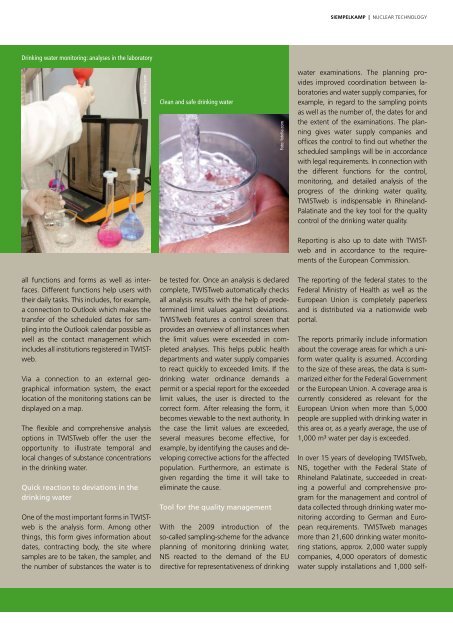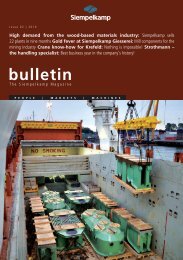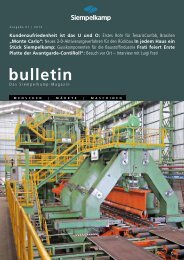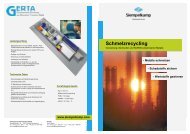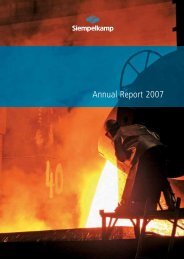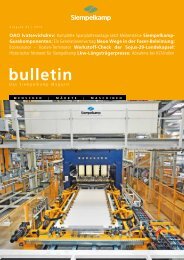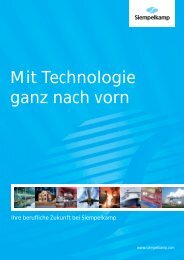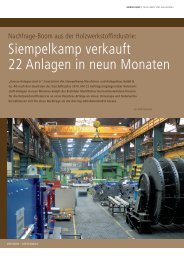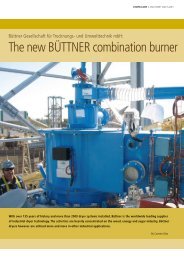Bulletin 1/2011 - Siempelkamp
Bulletin 1/2011 - Siempelkamp
Bulletin 1/2011 - Siempelkamp
You also want an ePaper? Increase the reach of your titles
YUMPU automatically turns print PDFs into web optimized ePapers that Google loves.
Drinking water monitoring: analyses in the laboratory<br />
all functions and forms as well as interfaces.<br />
Different functions help users with<br />
their daily tasks. this includes, for example,<br />
a connection to Outlook which makes the<br />
transfer of the scheduled dates for sampling<br />
into the Outlook calendar possible as<br />
well as the contact management which<br />
includes all institutions registered in tWIStweb.<br />
Via a connection to an external geographical<br />
information system, the exact<br />
location of the monitoring stations can be<br />
displayed on a map.<br />
the flexible and comprehensive analysis<br />
options in tWIStweb offer the user the<br />
opportunity to illustrate temporal and<br />
local changes of substance concentrations<br />
in the drinking water.<br />
Quick reaction to deviations in the<br />
drinking water<br />
One of the most important forms in tWIStweb<br />
is the analysis form. Among other<br />
things, this form gives information about<br />
dates, contracting body, the site where<br />
samples are to be taken, the sampler, and<br />
the number of substances the water is to<br />
Foto: fotolia.com<br />
Clean and safe drinking water<br />
be tested for. Once an analysis is declared<br />
complete, tWIStweb automatically checks<br />
all analysis results with the help of predetermined<br />
limit values against deviations.<br />
tWIStweb features a control screen that<br />
provides an overview of all instances when<br />
the limit values were exceeded in completed<br />
analyses. this helps public health<br />
departments and water supply companies<br />
to react quickly to exceeded limits. If the<br />
drinking water ordinance demands a<br />
permit or a special report for the exceeded<br />
limit values, the user is directed to the<br />
correct form. After releasing the form, it<br />
becomes viewable to the next authority. In<br />
the case the limit values are exceeded,<br />
several measures become effective, for<br />
example, by identifying the causes and developing<br />
corrective actions for the affected<br />
population. Furthermore, an estimate is<br />
given regarding the time it will take to<br />
eliminate the cause.<br />
Tool for the quality management<br />
Foto: fotolia.com<br />
With the 2009 introduction of the<br />
so-called sampling-scheme for the advance<br />
planning of monitoring drinking water,<br />
nIS reacted to the demand of the EU<br />
directive for representativeness of drinking<br />
SieMpelkaMp | nUCLEAR tECHnOLOGy<br />
water examinations. the planning provides<br />
improved coordination between laboratories<br />
and water supply companies, for<br />
example, in regard to the sampling points<br />
as well as the number of, the dates for and<br />
the extent of the examinations. the planning<br />
gives water supply companies and<br />
offices the control to find out whether the<br />
scheduled samplings will be in accordance<br />
with legal requirements. In connection with<br />
the different functions for the control,<br />
monitoring, and detailed analysis of the<br />
progress of the drinking water quality,<br />
tWIStweb is indispensable in Rhineland-<br />
Palatinate and the key tool for the quality<br />
control of the drinking water quality.<br />
Reporting is also up to date with tWIStweb<br />
and in accordance to the requirements<br />
of the European Commission.<br />
the reporting of the federal states to the<br />
Federal Ministry of Health as well as the<br />
European Union is completely paperless<br />
and is distributed via a nationwide web<br />
portal.<br />
the reports primarily include information<br />
about the coverage areas for which a uniform<br />
water quality is assumed. According<br />
to the size of these areas, the data is summarized<br />
either for the Federal Government<br />
or the European Union. A coverage area is<br />
currently considered as relevant for the<br />
European Union when more than 5,000<br />
people are supplied with drinking water in<br />
this area or, as a yearly average, the use of<br />
1,000 m³ water per day is exceeded.<br />
In over 15 years of developing tWIStweb,<br />
nIS, together with the Federal State of<br />
Rhineland Palatinate, succeeded in creating<br />
a powerful and comprehensive program<br />
for the management and control of<br />
data collected through drinking water monitoring<br />
according to German and European<br />
requirements. tWIStweb manages<br />
more than 21,600 drinking water monitoring<br />
stations, approx. 2,000 water supply<br />
companies, 4,000 operators of domestic<br />
water supply installations and 1,000 self-


